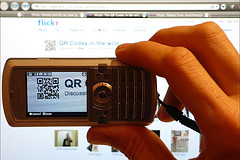 PayPal launched a quick response (QR) code campaign for Valentine’s Day in Singapore that allows people to make purchases by scanning QR codes on large ads posted on subway walls. The QR code ads are being called “mobile shopping walls” and can be found in 15 subway stations throughout Singapore. PSFK reports that each ad featured a different Valentine’s Day product offer from one of eight participating retailers.
PayPal launched a quick response (QR) code campaign for Valentine’s Day in Singapore that allows people to make purchases by scanning QR codes on large ads posted on subway walls. The QR code ads are being called “mobile shopping walls” and can be found in 15 subway stations throughout Singapore. PSFK reports that each ad featured a different Valentine’s Day product offer from one of eight participating retailers.
Consumers simply needed to download the PayPal QR code reader app to their mobile devices, and then scan the QR code using the app. Once the QR code was scanned, the consumer would be led directly to the login page for his or her PayPal account where the advertised product could be purchased instantly.
There is no doubt that these ads targeted impulse shoppers who needed to make last-minute Valentine’s Day gift purchases. For PayPal and the participating retailers, the campaign made it incredibly easy for consumers to respond to the ads and close a transaction quickly and easily. It’s great to see this type of direct marketing through QR codes which have been primarily used to lead consumers to informational pages, lead forms, and contests in the past.
Of course, QR codes are still in their infancy and until more consumers not only learn how to use them but also deem the effort required to use them as valuable enough, their growth will be slow. In mid-2011, comScore reported that only 6.2% of the U.S. mobile population had scanned a QR code on their mobile devices. The majority of scanned QR codes were found in newspapers and magazines (49.4%) or on product packaging (35.3%). Furthermore, 58% of mobile users who scanned QR codes did so at home, and 63.9% scanned QR codes at a retail or grocery store (39.4% and 24.5%, respectively).
It’s only a matter of time until we start seeing more brands using QR codes in creative ways and places to actually drive real-time, direct sales. However, the shift to launching transactional QR codes needs to happen quickly before a larger percentage of the mobile population perceives them as strictly informational and lacking added value. Education and re-education need to happen in order for QR codes to have a chance at long-term success for brands and businesses.
What do you think about the future of QR codes? Can they turn into transactional tools that add value to consumer brand experiences? Leave a comment and share your thoughts.
Image: CoCreatr
Susan Gunelius is the author of 10 marketing, social media, branding, copywriting, and technology books, and she is President & CEO of KeySplash Creative, Inc., a marketing communications company. She also owns Women on Business, an award-wining blog for business women. She is a featured columnist for Entrepreneur.com and Forbes.com, and her marketing-related articles have appeared on websites such as MSNBC.com, BusinessWeek.com, TodayShow.com, and more.
She has over 20 years of experience in the marketing field having spent the first decade of her career directing marketing programs for some of the largest companies in the world, including divisions of AT&T and HSBC. Today, her clients include large and small companies around the world and household brands like Citigroup, Cox Communications, Intuit, and more. Susan is frequently interviewed about marketing and branding by television, radio, print, and online media organizations, and she speaks about these topics at events around the world. You can connect with her on Twitter, Facebook, LinkedIn, or Google+.
